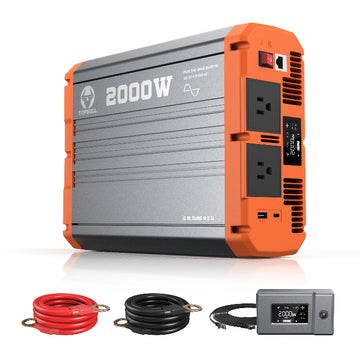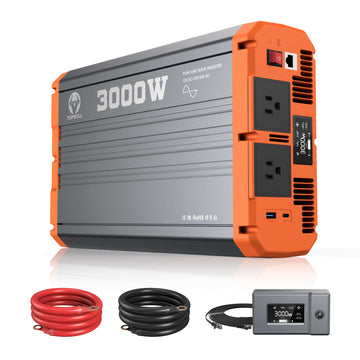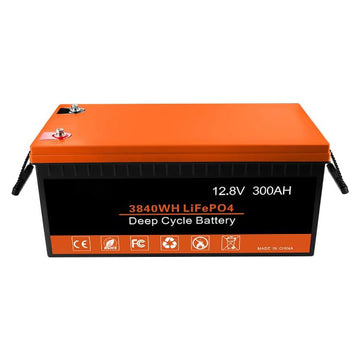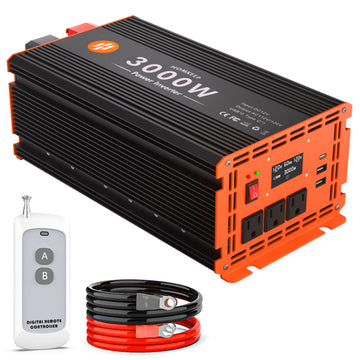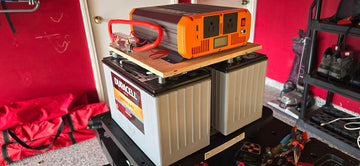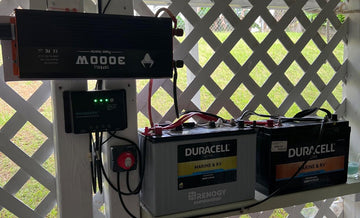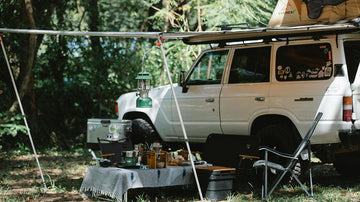Whether you're brewing your morning cup in a cozy kitchen, inside your RV, or at a remote campsite powered by batteries or solar, you may wonder: How many watts does a coffee maker use? Basically, most coffee makers use between 550 and 1500 watts, depending on the type, brewing method, and added features.
Understanding these wattage requirements isn't just for energy efficiency. If you're using limited power sources like power inverters, solar panels, or portable generators, knowing your coffee maker's energy demand helps you avoid overloads and ensures stress-free brewing, wherever you are.
In this guide, we'll break down how many watts different coffee makers use, how power consumption varies during brewing and standby, and a buying guide on choosing the best power inverter to match your setup for safe, reliable performance.
Related Reading:
How to Use an Inverter for Emergency Home Backup Power
What Size Power Inverter Is Needed for a House [Full Guide]
Coffee Maker Wattage Breakdown: By Type & Cup Size
The actual power consumption can vary widely depending on two key factors: the type of coffee maker and its brewing capacity (how many cups it makes per cycle). Whether you're choosing a compact single-serve unit or a high-output commercial machine, understanding these wattage differences helps you pick the right power inverter and avoid overloads, especially in RVs, off-grid cabins, or solar setups.
Coffee Maker Wattage by Type
| Type | Typical Wattage Range | Details |
| Drip Coffee Maker | 550 – 1200 W | Most common in homes; moderate usage, often includes a warming plate. |
| Single-Serve (e.g. Keurig, Nespresso) | 900 – 1500 W | Heats water quickly for each cup; higher wattage spike during brewing. |
| Espresso Machine | 1050 – 1500+ W | Uses high pressure and heat; often includes steam wands for frothing. |
| French Press / Manual | 0 W (no built-in heating) | Requires separately boiled water; wattage depends on the external kettle used. |
| Percolator | 800 – 1200 W | Recirculates boiling water through grounds; common for camping/RV use. |
| Commercial Machines | 1500 – 2500+ W | High-capacity units are found in cafes or offices. |
Note: Some smart coffee makers may draw standby power (1–5W), even when not actively brewing.
Coffee Maker Wattage by Cup Size
Larger brewers with bigger heating elements typically require more energy. Here's a rough breakdown based on brewing capacity:
| Capacity (Cups) | Estimated Wattage Range | Usage Context |
| 4-cup | 600 – 800 W | Small households or dorms |
| 5-cup |
650 – 900 W
|
Compact models for couples or light drinkers |
| 6-cup | 700 – 1000 W | Slightly larger, often still a single heating plate |
| 12-cup | 900 – 1200 W | Standard family size, most common drip machines |
| Commercial 20+ cup | 1500 – 2500+ W | Designed for office or cafe use |
Tip: Always check the manufacturer's label or manual for the exact wattage, as some models include warmers, grinders, or smart features that add to the total load.
Power Usage Stages: Brewing, Keeping Warm & Standby
While wattage ranges give you a general idea of how much power your coffee maker might consume, how and when that power is used can make just as big a difference, especially if operating off-grid or using a power inverter. Let's break down a coffee maker's three main power stages: brewing, warming, and standby.
Brewing: The Peak Power Phase
Brewing is the most energy-intensive part of the coffee-making process. During this stage, the machine rapidly heats water to the optimal brewing temperature, which demands a short, high-wattage burst—typically the top of the range (e.g., 1200–1500W for a Keurig or drip machine).
-
Single-serve machines often use the most power here due to the fast heating element.
-
Drip coffee makers also spike during brewing, especially larger 10–12 cup models.
- Espresso machines may sustain this high wattage longer because of pressure buildup and steam features.
Keeping Warm: Lower but Continuous Draw
Once the coffee is brewed, many machines switch to warming mode, using a hot plate or internal heating element to maintain coffee temperature.
-
Typical wattage: 50W – 150W, depending on the model.
- The warm mode can last 30 minutes to 2 hours if not turned off manually.
- If used multiple times a day, the energy used in this stage can surpass the brewing stage over time.
Standby Mode: Does It Still Use Power?
You might be wondering, how much electricity does a coffee maker use when not in use? Surprisingly, many models continue to draw a small amount of power even when they're idle. This standby consumption, typically between 1 to 5 watts, powers features like digital clocks, memory functions, or smart connectivity.
While this seems minimal, electricity can add up over time, especially for those using solar or battery-based setups. If every watt matters in your system, unplugging your coffee maker when not in use is a simple and effective way to reduce unnecessary energy drain.
Can You Use a Coffee Maker with a Power Inverter?
If you're brewing coffee while camping, on the road, or living off-grid, pairing your machine with a power inverter is essential. But before you plug in, there's one big consideration: Can your inverter handle the coffee maker's wattage?
Coffee Makers Demand High Power—Instantly
Most coffee makers require between 550 and 1500 watts during brewing, but some can draw even more for a brief moment when heating kicks in. This is called surge or peak wattage, and it can exceed 1500–1800W even for standard models. If your inverter isn't rated to handle both continuous and peak loads, you may risk:
- Tripping the inverter's fuse or overload protection
- Damaging the inverter or coffee maker
- Unexpected system shutdowns
Why a Pure Sine Wave Inverter Matters
Many household appliances, including coffee makers with digital displays, timers, or pumps, require pure sine wave output to run safely and efficiently. Using a modified sine wave inverter may cause:
- Unstable operation or odd noises
- Reduced heating efficiency
- Long-term damage to internal electronics
In short, if you're serious about brewing coffee off-grid without harming your gear, a high-quality pure sine wave inverter is non-negotiable.
Best Power Inverter for Your Coffee Maker: Topbull
Now that you understand your coffee maker's power needs, it's time to choose the right inverter to match. Whether you're brewing a single cup or powering a commercial-grade espresso machine, picking a properly sized inverter ensures stable performance and system safety.
To reliably power most coffee makers, whether you're at home, on the road in an RV, or living off-grid with solar, Topbull's pure sine wave inverters are an excellent choice. These inverters deliver stable, clean power that's safe for sensitive appliances like coffee makers. With high surge capacity, built-in safety protections, and models ranging from 2000W to 4000W, Topbull inverters are ideal for both everyday use and mobile setups.
Below, we've outlined the best inverter models and their recommended use cases to help you choose the right fit.
| Coffee Maker Type | Wattage Range | Recommended Topbull Inverter |
| Single-Serve (e.g., Keurig, Nespresso) | 900–1500W (surge ~1800W) | Topbull 2000W Pure Sine Wave Inverter |
| Drip Coffee Maker (4–12 cups) | 550–1200W (surge ~1500W) | Topbull 2000W Pure Sine Wave Inverter |
| Espresso Machine (home use) | 1200–1500W (surge ~2000W) | Topbull 3000W Pure Sine Wave Inverter |
| Commercial Coffee Machine | 1500W+ (surge ~2500–3000W+) | Topbull 4000W Pure Sine Wave Inverter |

Each Topbull inverter is engineered for demanding off-grid use, with features tailored for coffee makers and other kitchen appliances.
-
Pure Sine Wave Output: Ensures smooth, safe operation for sensitive electronics.
-
Reliable Surge Capacity: Easily handles the startup surge of heating elements.
-
Comprehensive Protection: Built-in safeguards against short circuit, overload, overheating, and undervoltage.
- RV & Off-Grid Friendly: Compact design, durable casing, and quiet fan make it perfect for mobile setups.
Whether you're a weekend camper or a full-time RV dweller, Topbull has a power solution that fits your coffee habit, offering a smooth, reliable, and safe power experience!
FAQs: Coffee Maker Wattage & Power Tips
How many watts does a Keurig coffee maker use?
Most Keurig single-serve coffee makers use between 900 and 1500 watts during brewing. The heating element draws the most power when starting up, but overall usage per cup is quite efficient.
How many watts does a 4, 5, 6, or 12-cup coffee maker use?
The wattage doesn't scale linearly with cup size, but generally:
-
4-cup makers use around 600–750W
-
5–6 cup models use 700–900W
-
12-cup machines can reach 1000–1200W
Drip-style machines with warming plates may draw low, continuous power even after brewing.
Can a coffee maker run on a power inverter?
Yes, as long as the inverter's continuous and surge wattage ratings exceed the coffee maker's requirements. A pure sine wave inverter is strongly recommended for compatibility and safety. Always check your appliance's wattage label before plugging it in.
Final Words
Understanding how many watts your coffee maker uses isn't just about saving energy; it's about choosing the right setup for your lifestyle. Whether you're brewing at home or living the van life, knowing your wattage helps you avoid overloads and ensures smooth, safe operation.
Topbull's pure sine wave inverters are built for exactly this kind of reliability. With strong surge handling, stable output, and compatibility across a range of coffee makers and devices, they're perfect for off-grid living, RVs, and solar setups. Brew coffee anywhere with the right inverter by your side. Choose Topbull and power your perfect cup, wherever life takes you!

